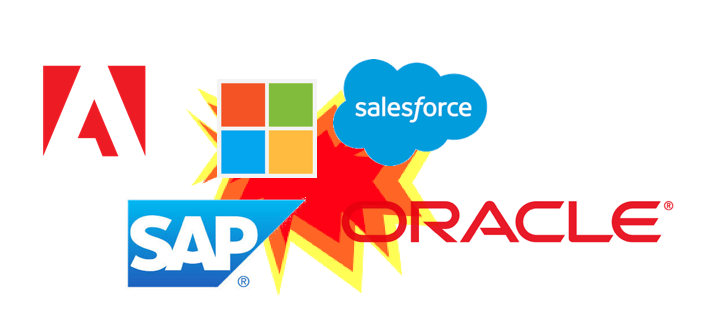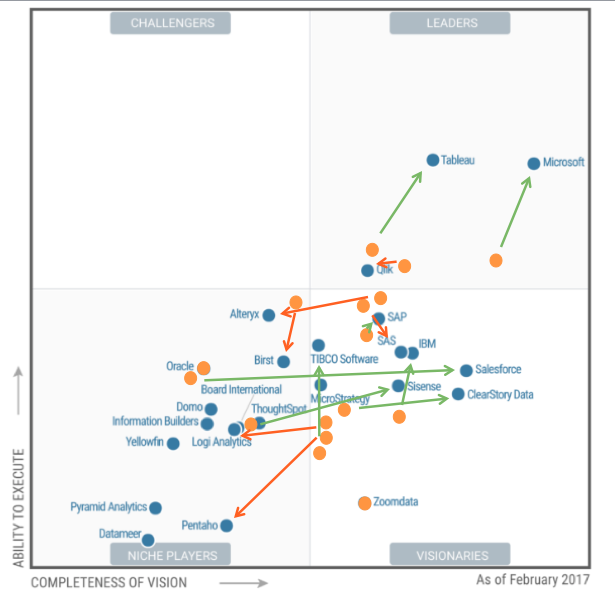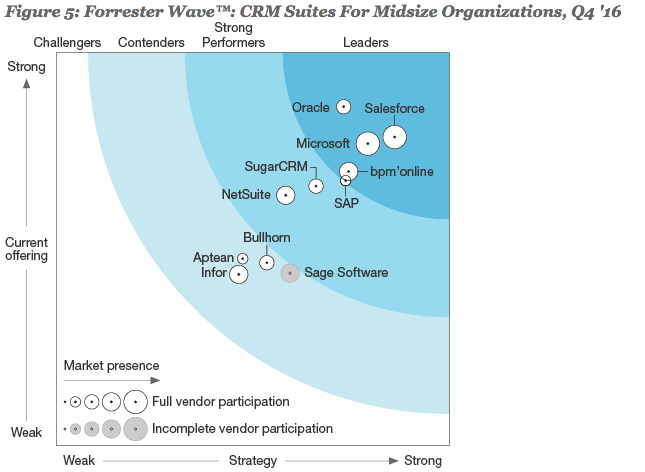
by twieberneit | Oct 28, 2017 | Blog |
The fall conference season is in full swing. Of the big 4 we had Oracle Open World and the SAP Hybris Summit, with the Salesforce Dreamforce, SAPPHIRE, and Microsoft Connect() still to come. I have covered the SAP Hybris Summit, so do not need to say much about it anymore. The event was short on great announcements – maybe they will come at SAPPHIRE – but certainly contributed to showing the clear vision forward that SAP has. And it is a compelling and consistent vision. OOW 17 was a different beast, most notably with the announcement of Oracle 18c. A year ago Oracle took Amazon full on, declaring it enemy number 1. Many analysts, including myself, were confused about this. Why Amazon and not Microsoft? After all Microsoft is the company that has a very credible IaaS, PaaS, and SaaS. Add the operating system and productivity software and you have a company with a formidable software stack that can be on the winning side of a Clash of Titans. While CTO Larry Ellison still took pot shots at Amazon in his keynotes, one can come to the conclusion that these are a kind of diversion, and that Oracle is back in best Musashi style. Oracle steps up its IaaS game The AI driven automation of Oracle 18c is game changing in the database play, and hence in IaaS. The new container engines should bring Oracle’s cloud on par with AWS and Azure. All three, Microsoft, Salesforce, and SAP now have something to chew upon. SAP, because their databases are now lacking a real important argument. And that has an...

by twieberneit | Mar 10, 2017 | Analysis, Blog |
On Mach 8, 2017, SAP and Google announced another marriage in the cloud during Google’s Cloud Next event: SAP HANA is certified on Google’s Cloud Platform GCP, and is generally available now. SAP Cloud Platform and more products and solutions are to follow. The Google Cloud Launcher marketplace will be utilized to offer and deploy to and for customers and partners, starting with SAP HANA, express edition, which is already available, too. Further topics that are covered by this partnership are Improving Google’s containerization technologies for enterprise workloads Security, privacy, and integrity of customer data in the cloud. As part of this SAP software shall act as a data custodian (NB: How that works in legal and political environments remains to be seen) and joint solutions for access control, governance, risk and compliance shall get developed Integrate Google’s G Suite into SAP applications. This has already been implemented for Identity and Access Management. More on the still fuzzy side are end-to-end integrations and collaborations in the areas of AI and machine learning. True to the SAP mantra of being an ecosystem player this is all about choice – choice for the customer to implement what is best for them. My Take Another interesting one! Good Win for SAP SAP now covers all major cloud platforms. HANA is now certified on AWS, Azure, and GCS, apart from running in the SAP cloud. With this SAP now has the broadest footprint when it comes to running on an IaaS platform. With the SAP Cloud Platform being available soon there also will be a very powerful PaaS solution on one of the...

by twieberneit | Feb 22, 2017 | Analysis, Blog |
Last week Gartner published the updated version of its Magic Quadrant for Business Intelligence and Analytics Platforms, and I need to say that there has been a lot of movement in both directions, up as well as down. There has been a lot of reshuffling especially in the Visionaries quadrant. This can partly be attributed to a changing market that caused Gartner to combine a few of last year’s assessment criteria as well as adding two more critical criteria as below: Critical Capabilities Dropped or Changed: Combined BI Platform Administration with Security and User Administration Modified Data Source Connectivity to Data Source Connectivity and Ingestion Combined Publish Analytics Content and Collaboration and Social BI to Publish, Share and Collaborate on Analytic Content Added Visual Appeal to Ease of Use Capabilities Added: Smart Data Discovery Platform Capabilities Workflow Integration Smart Data Discovery emphasizes the increasing importance of AI and machine learning as part of analytics systems. Gartner defines it around the automatically “finding, visualizing and narrating of important findings such as correlations, exceptions, clusters, links and predictions in data that are relevant to users without requiring them to build models or write algorithms. Users explore data via visualizations, natural-language-generated narration, search and natural-language query technologies”. Workflow Integration acknowledges that there is no actionable insight if there is a standalone analytics system. It is defined around the number of products “needed to deliver the critical capabilities and the degree of seamless integration and workflow between capabilities/components”. This has been true for a long time, but hey, better late than never. Gartner itself states that the changes have been major and that...

by twieberneit | Dec 1, 2016 | Analysis, Blog |
Finally, the much-anticipated Forrester Wave on CRM Suites for Mid-Sized Businesses Q4/2016 has been published by Kate Leggett and her team at Forrester Research. Besides the usual suspects Oracle, Microsoft, Salesforce, and SAP it covers 7 more vendors that fulfil Forrester’s definition of a CRM suite for mid-sized businesses. This definition roughly is To be considered a suite the software covers at least three of the CRM disciplines Marketing Sales Force Automation Customer Service Field Service E-Commerce Customer Analytics There needs to be prebuilt integration between the products, if they are not within the same system; integration shall be via open standards to allow for integrating other applications. The software needs to be targeted at organizations between 250 and 999 employees. Multiple industries need to be targeted. Of course, the solutions need to be in active use and there need to be customer references. The Forrester Wave has some interesting results, some confirming what other people see, too, others somewhat surprising. Let me start with the confirmations, continue with bits that surprised me, and close with an SAP specific view. The Confirmations Of course, we are talking cloud – cloud and nothing else. As can be expected all vendors strive to deliver a toolset that helps their customers to deliver consistent customer experiences. Now I, and others, would argue that the experience is largely in the realm of the end customer and the users and that there is nothing like a ‘system of experience’. Delivering consistent experiences encompasses far more than a CRM suite. But then it is far easier (and sexier) to talk about delivering experiences than about...

by twieberneit | Oct 11, 2016 | Analysis, Blog |
Following all those announcements of AI, machine learning, IoT, IaaS, PaaS and what not over the past months, I was beginning to wonder where the big business software vendors are going. What is the game plan of Microsoft, Oracle, Salesforce, SAP? How does newcomer Adobe fit in there? Maybe Amazon and Google, too; or Facebook. It is a time for another Quo Vadis – this time: Quo Vadis, industry? Clash of Titans In the last about 2 – 3 years we have seen a strong acceleration of innovation, or at least talk about it. Cloud computing, offering nearly unlimited scalability and elasticity of computing resources has become main stream. Cloud computing also allows for nearly 100 per cent uptime Since the advent of the iPhone (yes, I know this was earlier than 2013) the proliferation of sensors has increased a lot, resulting in them becoming cheaper and cheaper, allowing for an increasing number of data rich applications This has also driven fast mobile connectivity, which has become nearly ubiquitous; maybe except a few blessed spots on this planet, which will be covered soon, too. Think of Google’s Balloon project or Facebook’s drone Memory has become dirt cheap, and fast In-memory technologies, No-SQL databases, Hadoop, Spark, and improvements of analytics algorithms make it possible to work with huge sets of data in real time The (re-)emergence of AI technologies, progress in machine learning and deep learning, enabled by the now available computing power, help in pattern recognition that allows machine driven suggestion, prediction, and prescription of actions, based upon huge amounts of data Data, be it machine-generated or human created...






